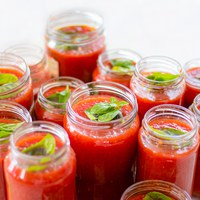Prairie Fare: Canning Lids Coming Soon to a Store Near You (We Hope)
(Click an image below to view a high-resolution image that can be downloaded)
By Julie Garden-Robinson, Food and Nutrition Specialist
NDSU Extension
“They’re in at the grocery store,” my friend texted.
I texted my husband.
“They’re in,” I noted. “Pick up the limit. I probably need six boxes this year.”
Later I mentioned on a Zoom call that I had found canning lids.
“Where did you get them?” someone texted.
I told her and she went to the store. They were all gone by the time she arrived.
Who would have thought that canning lids were going to be a hot commodity? They have been hard to find during the pandemic. The shelves with canning supplies were empty in many stores.
I am glad that people are interested in home-preserving food. I hope the lids weren’t being used widely for crafts.
We all need to be responsible buyers and not stock up for the next few years. Let’s spread the supply around and buy only what we need at present.
When I found some boxes of jars with lids, I bought a couple of boxes. Now I have a lot of jars. I hope my garden is very productive because I am equipped.
We have been assured by a major manufacturer of lids that it is working hard to have the supplies in place by canning season.
Many of us grew up with home-canned food. Maybe you have seen some of the “antique” jars or lids that your parents or grandparents may have used.
Unfortunately, people were grabbing the antique lids and trying them out. Others were reusing lids on commercial jars. We do not recommend doing either of those things.
Use the antiques for room decor or crafts, not preserving food.
Jars can be used again and again, as long as the rims are not chipped and the jars are not cracked or otherwise damaged.
Metal canning lids with the sealant under the lids can be used only one time to preserve food. The metal rings can be used multiple times.
I know we do not like to waste things. If the lids aren’t damaged, you could reuse the metal lids in crafts. I have seen some nifty garden markers made from painted reused lids, for example.
Some reusable lids are available with thin rubber gaskets. They have not undergone the level of testing and research as the metal lids. You might see more seal failures as a result.
Here are some tips about lids and canning in general.
- Follow the manufacturer’s directions for preparing lids. Traditionally, lids were simmered or boiled prior to applying to jars, but this generally is not the case now. Check the directions on the lid package or manufacturer’s website.
- Always wash and rinse lids and bands prior to use. Do not use a dishwasher to clean the bands because this can increase the risk of the metal pieces rusting.
- Leave the proper head space. The unfilled space above the food in a jar and below its lid is referred to as head space. Each home-canned food product has a specific recommendation for the depth of the head space. For example, sweet spreads should have a head space of 1/4 inch.
- Clean the jar rim (sealing surface) prior to applying the lid. Food residue trapped on the jar rim can cause seal failures.
- Place the metal screw band over the flat lid and apply fingertip tight. In other words, place the screw band on the jar, turn it just until you feel resistance, then turn the band one-quarter turn more. Screw bands that are applied too loosely or too tightly can cause jars to not seal properly.
- After processing, remove jars from the canner and allow to cool 12 to 24 hours undisturbed. Do not retighten screw bands. Once jars are completely cool, check for the seal. Removing the screw bands for storage is a best practice. When removed, washed, dried and stored in a dry area, screw bands may be used many times.
If your garden is bountiful with vegetables, be sure to follow the current guidelines. Great-grandma’s recipes may not be safe with more recent varieties of vegetables. They may be less acidic because of the changing preferences of our palates.
Use a pressure canner and current U.S. Department of Agriculture processing guidelines to can low-acid foods such as vegetables and mixtures of food.
Acidify tomatoes with the recommended amount of bottled lemon juice or citric acid prior to canning (1 tablespoon of bottled lemon juice per pint of tomatoes; 2 tablespoons per quart). Be sure to process the tomatoes for the recommended time.
Use research-tested salsa recipes and don’t alter ingredient proportions. If you create your own salsa and want to preserve it, freezing it is the safest option.
Seal jams and jellies with a regular canning lid (not wax) and process in a boiling-water bath for five to 10 minutes, depending on altitude.
Remember that you are a scientist when you are preserving food. If you can’t find lids where you live, consider freezing the vegetables or fruits.
Instead of a recipe, I have an invitation for you to explore the bountiful food preservation materials that are available on our website. Want to make strawberry jam? How about canned salsa? How can you freeze your spinach? How do you make fruit leather from various fruits?
See http://www.ag.ndsu.edu/food for free, research-tested food preservation resources (canning, pickling, making jams and jellies, drying, freezing).
(Julie Garden-Robinson, Ph.D., R.D., L.R.D., is a North Dakota State University Extension food and nutrition specialist and professor in the Department of Health, Nutrition and Exercise Sciences. Follow her on Twitter @jgardenrobinson)
NDSU Agriculture Communication
Source: Julie Garden-Robinson, 701-231-7187, julie.garden-robinson@ndsu.edu
Editor: Ellen Crawford, 701-231-5391, ellen.crawford@ndsu.edu




